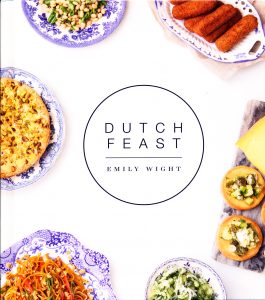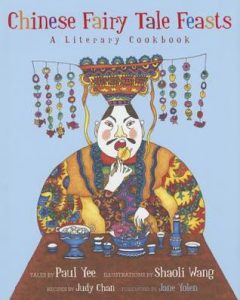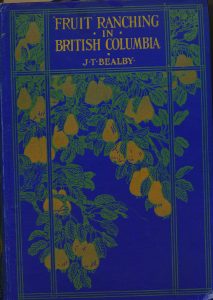Book reviews of cookbooks and other publications about food history are featured on this site. From time to time we will add more books that we have read and found interesting and relevant.
100th Postal Birthday Party Committee (1998). From Grannies to Grandkids, Falkland History through recipes. Falkland, BC: Author.
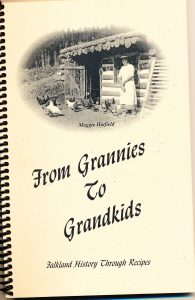 From Grannies to Grandkids, Falkland History through recipes is a charming little community cook book, coil-bound, 84 pages, 170 recipes and a combination of history, philosophy, poetry, photos, and food that conveys a picture of life in small town rural BC. It is organized into nine sections that provide an overview of the history of: The Postal Service, Courageous Pioneers, Valley Merchants, Canadian National Railroad, Gypsum Mine, Schools, The War Years, Churches, and Falkland Community. In closing, the authors note: “Some of the recipes sent in were written without methods, specific quantities of ingredients or were abbreviated in a unique way. We presented these recipes without changes, which we felt would add character to the recipes author” (p. 85).
From Grannies to Grandkids, Falkland History through recipes is a charming little community cook book, coil-bound, 84 pages, 170 recipes and a combination of history, philosophy, poetry, photos, and food that conveys a picture of life in small town rural BC. It is organized into nine sections that provide an overview of the history of: The Postal Service, Courageous Pioneers, Valley Merchants, Canadian National Railroad, Gypsum Mine, Schools, The War Years, Churches, and Falkland Community. In closing, the authors note: “Some of the recipes sent in were written without methods, specific quantities of ingredients or were abbreviated in a unique way. We presented these recipes without changes, which we felt would add character to the recipes author” (p. 85).
This book expects the user to have some knowledge of food preparation. For example a few recipes do not detail method of combining ingredients but simple state: “ Mix together like a cake.” There are no metric measures for recipes – Imperial only, and format for abbreviations varies. Contributors for all recipes are named and most are accompanied by stories. There is a vast range of and some rare and unusual recipes included: Baking Powder Bread, Oatmeal Water, Cake Doughnuts, Champagne, Haggis, Laxative, Exterior Wood Stain, Ginger Ale, Library Glue, Play Dough, Sweet Green Tomato Pickle, Pickled Chicken, and Coal Flowers. This is my go-to book for a recipe for Brownie Pudding, a comfort food from my childhood and still so delicious today! It’s like an inside out lava cake only better!
You might find the recipe for Coal Flowers interesting. Google claims they were invented by coal miners’ wives in the 1800s who had lots of coal and attempted to use it to create beautiful flower displays. The flowers are a result of a chemical reaction and crystal formation that grows from the coal.
Coal Flowers Ruby (Ferguson) Munsell
6 T. liquid bluing 6 T. water
6 T. salt 1 T. ammonia water
Mix together and pour over brick clinker or coal placed in a dish. Coat edges with Vaseline to prevent growth over the edges. Dab coal with coloured ink or food colouring.
The recipes in this book suggest that most everything was home-made in early years and creativity with common ingredients was a way of life. Inventiveness and frugality were valued. This book would be strengthened if it had an index. One must thumb through all the pages to find the recipe you are searching for. The anecdotes and stories scattered throughout provide enjoyable reading. Published 20 years ago, this book may be difficult to find but it is possible that the Falkland Museum and Heritage Park still has copies. That is where I found my copy several years ago.
Lang, Joan (2003). Lost orchards, vanishing fruit farms of the West Kootenays. Nelson BC: Author. ISBN: 0-9732350-0-4
 Lost orchards, vanishing fruit farms of the West Kootenays began as a thesis in the History Department at The University of Victoria in 1996. It documents the development and decline of the fruit industry in the West Kootenays, an area that encompasses Nakusp, Kaslo, Nelson, Castlegar, Trail and Creston. It contains tables that list pre-emptions of land made between 1888 and 1904 in the region and statistics on fruit production from 1913 to 1934. The bibliography is comprehensive and the book is indexed. It is beautifully illustrated with maps and archival photos in both colour and black and white.
Lost orchards, vanishing fruit farms of the West Kootenays began as a thesis in the History Department at The University of Victoria in 1996. It documents the development and decline of the fruit industry in the West Kootenays, an area that encompasses Nakusp, Kaslo, Nelson, Castlegar, Trail and Creston. It contains tables that list pre-emptions of land made between 1888 and 1904 in the region and statistics on fruit production from 1913 to 1934. The bibliography is comprehensive and the book is indexed. It is beautifully illustrated with maps and archival photos in both colour and black and white.
The Kootenay region of British Columbia was marketed to many British residents through books like J.T. Bealby’s Fruit Ranching in British Columbia and many British citizens and others from the prairies came to pre-empt land and settle on acreages sometimes as small as 10 acres. They worked and learned together trying to make a viable and sustainable industry. The Doukhobors were a second group of migrants to settle in the area. They worked cooperatively and lived communally and also became fruit growers.
The industry created by the settlers thrived for a short time. In 1920, Kootenay growers supplied 2/3 of the cherry crop in British Columbia. Strawberries and other small fruits grew abundantly. Jam factories were created and jam was shipped to the prairies and eastern provinces. The general economic decline of the 1930s severely impacted the struggling industry. The orchards were small compared to the larger ones developing in the Okanagan and the Okanagan had a warmer climate that was more supportive of fruit growth. Poor weather became a problem as did disease, pest infestations, and transportation. By 1950 the fruit industry of West Kootenay region had closed down. The next generation of the pioneering families moved on in pursuit of livelihoods in other sectors of the economy. The viable farming ventures of the early 1900s did not sustain themselves beyond 1950.
Lang documents an industry cycle that causes one to wonder if it was doomed from the outset or were decisions made along the way that prevented it from thriving in the long term? And, in the long term does it matter? Traces of the industry remain and it makes me wonder if a resurgence or a new industry cycle might emerge again.
Dutch Foods in Canada
Wight, Emily (2017). Dutch feast. Vancouver: Arsenal Pulp Press. ISBN 978-1-55152-687-4
Emily Wight is on a mission to inform us about and have us gain an appreciation for Dutch foods. She claims a couple of things have led to our under-appreciation of Dutch cuisine. First many tourists don’t experience foods beyond Amsterdam and thus miss out on some of the best foods available. Secondly the Dutch character that desires to fit in and not draw attention to itself has led to the cuisine being quietly present within homes rather than in restaurants, and foods that the Dutch have influenced such as coleslaw, pancakes, doughnuts and apple pie have quickly become North American food.
Wight describes Dutch cuisine as local, simply prepared, thrifty and practical. The bold flavours come from its colonial history and borrowing flavours from Indonesia, Suriname and neighbouring Belgium. She sums up Dutch cuisine as: “inspired by local, seasonal ingredients, international flavours, and a profound love for sugar, dairy products and breads feature prominently and cheese is a source of national pride” (p. 13).
Wight offers a very informative book; a great combination of recipes and information. She provides background information in each section and a brief commentary with each recipe. She includes brief history – for example that the Dutch occupied Indonesia for 350 years that ended only in 1949! Wight writes with humour and many personal anecdotes. She offers philosophy –“the way we eat can change how we see the world!” (p. 41) and gives a list of recipes such as butter cake, sugar bread, bitterballen, etc. to begin our cooking adventure if we are new to Dutch cuisine. Although most tempting to me is Salted Licorice Ice Cream! She provides extensive information on key foods such as licorice, pancakes, mashes, beer, genever, potatoes, herring and chocolate.
I loved this book because it offers recipes that anyone can try and teaches us a lot about Dutch cuisine. It will be appreciated by any new or experienced cook and teachers who may wish to expand their students’ understanding of international and heritage foods. It helped me gain an appreciation for the menu offerings at The Bulldog Grand Café on Silver Star Mountain in my neighbourhood. I’m ready to visit again soon and be more adventurous in my menu choices – Linda Peterat
First Nations – Innovative Cuisine
George, Andrew (2013). Modern native feasts, healthy, innovative, sustainable cuisine.
Vancouver: Arsenal Pulp Press. ISBN: 978-1-55152-507-5
Andrew George, author of Modern native feasts, healthy, innovative, sustainable cuisine is from Wet’suwet’en First Nation in northwest British Columbia. He was head chef at the Four Host First Nations pavilion of the 2010 Winter Olympics in Vancouver. He is a chef educator with a particular interest in encouraging healthy, local eating among First Nation youth (see www.storyhive.com/project/show/id/850). He has authored three recipe books.
This book is a fusion of traditional foods with modern ingredients and techniques. It promotes aboriginal cuisine and culture, using simple easily available foods. There are many recipes that use wild game (elk, venison, buffalo, rabbit, duck and geese). There are recipes that use wild ingredients: wild rice, dandelion, huckleberries, saskatoons, salmon, trout, nettles, and seaweed, for example; and recipes for stews, casseroles, breads, bannock, desserts, pasta, and breakfast foods. The recipes are beautifully illustrated and a brief explanatory note is included with each recipe.
Native Feasts has much to offer teachers wishing to incorporate First Nations foods into their curriculum and encourage aspiring First Nations chefs, and anyone who likes to experiment with wild game cooking or infuse more locally grown foods into their meal preparations – Linda Peterat
Story-Telling about Heritage Recipes
Langley Meals on Wheels Society (2011). Reminiscences, recipes & remedies, Langley seniors reminisce about their food heritage. Langley, BC: Author. ISBN: 978-0-9878398-0-0
 In 2010, with funding assistance from the federal government program New Horizons for Seniors, the Langley Meals on Wheels Society launched a project to gather stories focused on food and home remedies from seniors in the community. The seniors who told their stories were born in the 1920s, 30s, and 40s. They told of childhoods from all parts of Canada, growing up in small communities, rural schools and lives full of securing, processing and preparing foods. They told of ice houses, game hunting, berry picking, steam engines, no electricity or running water, and home remedies for common illnesses. The book contains 38 life stories and 24 recipes that include Potato Candy, Sauerkraut Cake, Scotch Eggs, Rabbit Stew, and Vinarterta.
In 2010, with funding assistance from the federal government program New Horizons for Seniors, the Langley Meals on Wheels Society launched a project to gather stories focused on food and home remedies from seniors in the community. The seniors who told their stories were born in the 1920s, 30s, and 40s. They told of childhoods from all parts of Canada, growing up in small communities, rural schools and lives full of securing, processing and preparing foods. They told of ice houses, game hunting, berry picking, steam engines, no electricity or running water, and home remedies for common illnesses. The book contains 38 life stories and 24 recipes that include Potato Candy, Sauerkraut Cake, Scotch Eggs, Rabbit Stew, and Vinarterta.
The stories in this book are short and could easily be shared in read-alouds among groups or in classrooms. Like all life stories they evoke personal memories and questions for discussion. The book came about when one of the project leaders and a group of seniors were talking around a table. The leader recognized that there were “a lot of great life stories” and memories that should be documented before they disappear.
This book should inspire teachers who want to help their students engage in intergenerational work and study of food practices in their community. Every community has life stories among seniors that should be preserved!
– Linda Peterat
Templeman-Kluit, A. (Ed.). (1999). A west coast Christmas, celebrating the season on the edge of the Pacific.
Vancouver/Toronto: Whitecap Books.
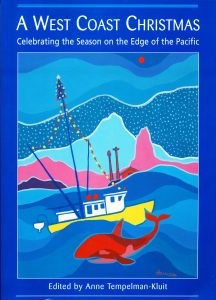 This is a great little book to pick up and read around Christmas time. Pull up a cozy chair, grab a favourite beverage and if there are others around, do a read-aloud. The stories are short and sure to evoke memories and questions about earlier days. This is a book about food and traditions of the Christmas season in the lives of miners, loggers, early settlers, and First Nations peoples from about the 1850s to 1950s. The stories and poetry included are from published books, journals and conversations. Many are humourous and short. Eight recipes are included in the book, one for scrumpy, a warm non-alcoholic beverage served by the Empress Hotel in Victoria. The book is beautifully illustrated with historic photos and prints of old Christmas cards, menu cards, and artifacts.
This is a great little book to pick up and read around Christmas time. Pull up a cozy chair, grab a favourite beverage and if there are others around, do a read-aloud. The stories are short and sure to evoke memories and questions about earlier days. This is a book about food and traditions of the Christmas season in the lives of miners, loggers, early settlers, and First Nations peoples from about the 1850s to 1950s. The stories and poetry included are from published books, journals and conversations. Many are humourous and short. Eight recipes are included in the book, one for scrumpy, a warm non-alcoholic beverage served by the Empress Hotel in Victoria. The book is beautifully illustrated with historic photos and prints of old Christmas cards, menu cards, and artifacts.
This is a book to be shared and discussed. It could be valuable in classrooms, families, and intergenerational settings where memories and past experiences can be a part of the conversation. – Linda Peterat
Gulf of Georgia Cannery Society (2002). Trademarks and salmon art: a brand new perspective.
Richmond, BC: Author.
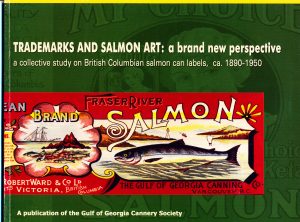 This book contains a brief overview of the history of the Gulf of Georgia Cannery in the context (including a map) of the broader cannery history on the west coast of BC. It includes two research papers: “Selling Salmon: Early British Columbia Salmon Can Labels” by Claudia Lorenz and “Unpacking the Label: British Columbia Salmon Can Label Imagery in the 20th Century” by Kathryn McKay. McKay and Lorenz were University of Victoria students who through a Community-University Research Alliance grant partnered with the Cannery Society to investigate influences on the Salmon can imagery. Lorenz’s paper addresses the context influencing the production of can labels and McKay’s paper focuses on the label imagery itself. The book includes colour plates of salmon can labels and photos of the exhibit by local artists “Trademarks and salmon art” through which artists responded to the research papers.
This book contains a brief overview of the history of the Gulf of Georgia Cannery in the context (including a map) of the broader cannery history on the west coast of BC. It includes two research papers: “Selling Salmon: Early British Columbia Salmon Can Labels” by Claudia Lorenz and “Unpacking the Label: British Columbia Salmon Can Label Imagery in the 20th Century” by Kathryn McKay. McKay and Lorenz were University of Victoria students who through a Community-University Research Alliance grant partnered with the Cannery Society to investigate influences on the Salmon can imagery. Lorenz’s paper addresses the context influencing the production of can labels and McKay’s paper focuses on the label imagery itself. The book includes colour plates of salmon can labels and photos of the exhibit by local artists “Trademarks and salmon art” through which artists responded to the research papers.
The salmon can labels reflect both the times in terms of marketing strategies and printing capabilities. The labels communicated more than information about the product itself. The research papers provide a good example for others wishing to analyze food product labels and marketing strategies. The whole project report provides an example for community engagement around a food history theme. – Linda Peterat
The Monster Cannery: The history of the Gulf of Georgia Cannery
Gulf of Georgia Cannery Society (2011). The monster cannery, the history of the Gulf of Georgia Cannery.
Richmond, BC: Author.
With fr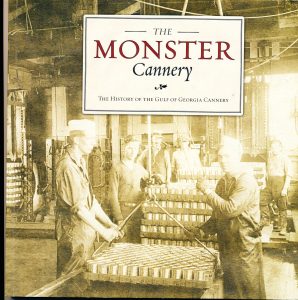 ee admission throughout 2017 in celebration of Canada’s 150th birthday, it’s been a great year to visit the Gulf of Georgia Cannery, a National Historic site.
ee admission throughout 2017 in celebration of Canada’s 150th birthday, it’s been a great year to visit the Gulf of Georgia Cannery, a National Historic site.
If you can’t visit, The Monster Cannery is a good substitute. Tt’s worth picking up this book as a reminder of the huge industry that the fishery once was on the West Coast. Salmon was a trading commodity used by the First Nations people for centuries and became an export of the Hudson’s Bay Company at Fort Langley as early as the 1830s. The Gulf of Georgia Cannery opened in 1894 and became one of more than one hundred that existed along BC’s coast. The story of the Cannery is the story of the people who came to work in the industry – First Nations, Greek immigrants, the Chinese and Japanese, people from the Canadian prairies, families, and lots of women.
The Cannery story is also a story of technology beginning with the idea of “canning” that made its way to the BC Coast in 1867 and all the machines and equipment that developed to carry out fishing, storing, preparing and processing canned fish and fish products. Many small unions among the gillnetters, cannery workers, and the seafarers for example, developed. In 1945, The United Fishermen and Allied Workers’ Union (UFAWU) became powerful by uniting the interests of many of the small unions in the struggle for improved wages and working conditions.
The Monster Cannery contains many photos of artifacts and action shots within the cannery and its surroundings. It’s a fascinating read about one industry, its significance and societal impact, its challenges and eventual closure. It’s recommended reading for all BC residents in understanding their food history and useful for history, business and food instructors and students. In 1975, members of the Steveston Historical Society began efforts to have the Cannery designated a National Historic site and today it is a significant education and history facility. – Linda Peterat
Memories and Meals
Enderby & District Museum Society. (1999). Memories and Meals, from the families of Enderby& District. Enderby, BC: Author.
NOTE: Book is available at the Enderby and District Museum and Archives, Box 367 – 901 George Street
Enderby, BC, V0E 1V0, [email protected], 250-838-7170
This is a community cook book assembled by a Committee of the Enderby Museum Society. A former or present member of the community has contributed each recipe. Brief family histories are included as well as stories of the significance of a recipe in a family’s history or description of when it was prepared by the family. Recipes are simple and basic often using local ingredients. For example, in the section on vegetables and sauces that contains eleven recipes, three use turnips and two potatoes in their preparation. There are lots of recipes for sourdough breads and doughnuts. Some novel recipes such as “snake bread” and “Meeshlays” provide insight into local family traditions. There are recipes for the usual main courses, cookies, and cakes – in fact, lots of cake recipes including the 1937 Free Press $1.00 Cake; puddings, and pies. Novelty recipes for “tonic”, homemade yeast, fly poison, homemade soap and even beet wine add intrigue. Each of the thirteen recipe sections contains an introductory reminiscence about food from a community member and photos from the archives are scattered throughout. The book is a fascinating portrayal of Enderby and its people – Linda Peterat
Chinese Fairy Tale Feasts
Chinese fairy tale feasts, a literary cookbook.
Yee, Paul, Chan, Judy, & Wang, Shaoli (2014). Chinese fairy tale feasts, a literary cookbook.
Vancouver, London: Tradewind Books. ISBN 978-1-896580-68-5
This is a gorgeous little book – beautifully illustrated by Shaoli Wang, with recipes by Judy Chan and stories by Paul Yee. It contains 13 chapters, each beginning with a story either written or adapted by Paul Yee. Each story involves food or cooking in some way and is followed by brief interpretive notes on the origin of story and its main messages. Judy Chan includes a related recipe with notes on how the recipe relates to her family practices and the story.
This is a fabulous book to work through with children. It inspires intergenerational participation – grandparent with grandchild, parent with child, teacher with a class of students. There is everything one needs – a story to read, notes for discussion, clearly written equipment and ingredient lists and instructions for making the recipe – and much to learn for all ages! The illustrations are vivid and support the stories and recipes.
This book provides a model for cross-cultural learning through food. Paul Yee explains the Chinese origin of the various stories and their themes, and links them to stories from other cultures when possible. The recipes become food for thought as well as for body nourishment. It is worth noting this is an award winning book (2015 Gourmand Award for Best Canadian Cookbook) that should enjoy widespread classroom and home use. – Linda Peterat
Fruit Ranching in British Columbia
Bealby, J.T. (1909, 1911). Fruit Ranching in British Columbia.
Toronto: Macmillan.
When I came upon Fruit Ranching in British Columbia a few years ago in a used bookstore in London, ON I was drawn to the beautiful cover. I couldn’t resist buying it so I could find out who Bealby was and on what basis fruit “ranching” was being encouraged.
Paul Koroscil (2003, 2008) would clearly characterize Bealby as one of the “promoters” or “developers” who from 1890 to the 1920s were very active in promoting the sale and transition of the ranch lands of the Southern Interior of BC from cattle ranching into orchards. Usually these promoters were British settlers who saw that profits could be made by selling the ranch lands to other Brits or colonials who were seeking better farm land and climate. Bealby owned a “fruit ranch” in Nelson and used his book to promote his services that included advising on purchase of lands and managing them for absentee owners. He deals at length with how to establish an orchard, make it financially profitable, and grow award winning quality fruit. He explains the BC landscapes, the dangers of floods, droughts and forest fires, wildlife, and the manners and life of Canadians.
This book is useful to anyone who wants to understand the beginnings of fruit growing in BC’s Southern Interior and the forces that influenced settlement of this area in the early 1900s.
In addition to being published in Canada, this book was also published in Australia, the United States and India. It is now in public domain in Canada and available on line:
Koroscil, Paul M. (2003, 2008). The British garden of Eden, settlement history of the Okanagan Valley, British Columbia. Burnaby: Simon Fraser University.
Book Reviews related to Food History in BC Studies This link will take you to a list of books reviewed in BC Studies, a peer-reviewed journal.

